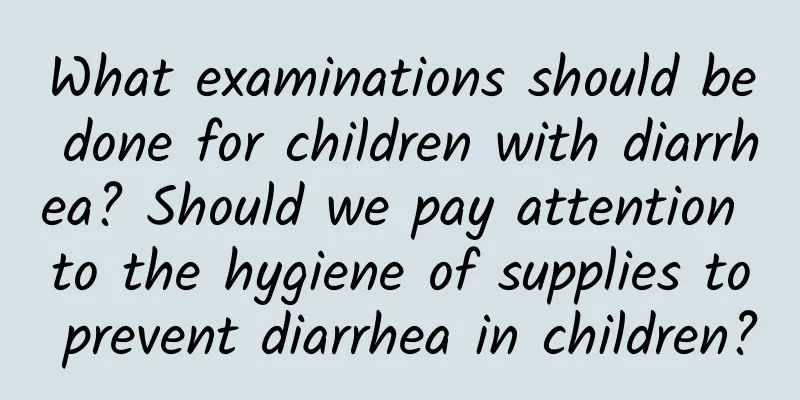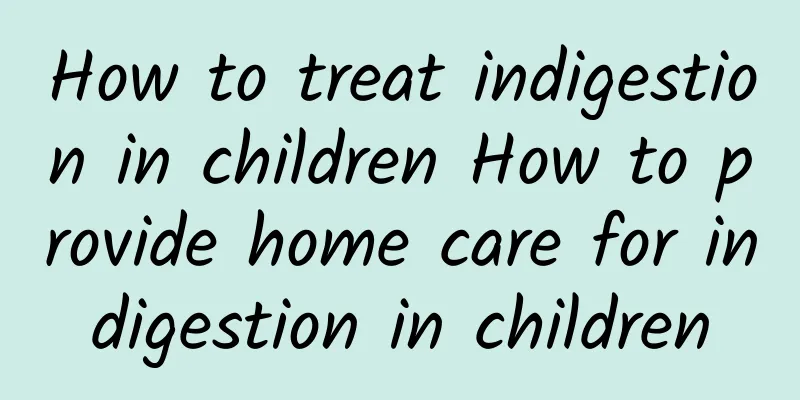What examinations should be done for children with diarrhea? Should we pay attention to the hygiene of supplies to prevent diarrhea in children?

|
Every step of a child's growth makes parents happy or worried. Parents are happy when their children grow up, but they will be worried if they get sick in the process. Pediatric diarrhea is a common and high-incidence disease in pediatrics. Many children have experienced it, which is also a headache for parents. Parents should learn how to prevent pediatric diarrhea in daily life. Let's take a look below. How should parents prevent diarrhea in children? 1. Enhance children's resistance Children are in the growth and development stage, and their resistance to the outside world is weak, so they are prone to diarrhea. Therefore, the most important way to prevent diarrhea in babies is to enhance their resistance. In addition to strengthening outdoor activities to improve the baby's ability to adapt to the natural environment and improve the body's resistance, it is also necessary to appropriately add vitamin supplements, which can help children improve their body's defense capabilities and significantly reduce the incidence of diarrhea. During the period of diarrhea, fat-soluble vitamins such as cod liver oil will aggravate the baby's diarrhea. Therefore, water-soluble vitamin drops should be selected for the baby at this time. Water-soluble vitamin drops can not only effectively absorb the nutrients of vitamins during diarrhea, but also will not aggravate diarrhea. It allows the baby to supplement vitamins well during the sick stage, enhance the baby's physical strength and resist viruses. 2. Pay attention to cleaning and disinfection Some pediatric diarrhea is caused by infection with bacteria, viruses, etc. These pathogens can enter the baby's body through food, tableware, and physical contact. Therefore, it is very important to maintain hygiene in the baby's living environment and disinfect the items used. Before feeding the baby, you must wash your hands; the milk bottles, bowls, spoons, etc. used by infants and young children should be boiled and disinfected at least once a day, or scalded with boiling water before use; maintain good hygiene habits, bathe the baby frequently and change clean clothes. Only in a good hygienic environment can diarrhea be effectively prevented. 3. Pay attention to dietary prevention In order to raise a healthy baby, mothers are advised to adhere to breastfeeding. Breast milk is a pure natural drink. Babies can obtain various substances from breast milk to resist intestinal infections and reduce the occurrence of diarrhea. For babies who are adding complementary foods, it is necessary to do it step by step: from less to more, from thin to thick, from fine to coarse. This can give the digestive system an adaptation process, avoid diarrhea, and ensure absorption. Diarrhea examination methods in children 1. Routine stool examination: Microscopic examination of stool, pay attention to the presence of pus cells, white blood cells, red blood cells and macrophages, and also pay attention to the presence of worm eggs, parasites, fungal spores and hyphae. 2. Stool culture: It is important to determine the pathogen of diarrhea. The positive rate of stool culture is low in one time, so it needs to be done several times. Immediate culture of fresh specimens can increase the positive detection rate. 3. Stool latex agglutination test: It has diagnostic value for some viral enteritis, such as rotavirus, intestinal adenovirus, etc. It has good sensitivity and specificity, and is helpful for the diagnosis of Campylobacter jejuni enteritis. 4. Enzyme-linked immunosorbent assay: It is highly sensitive and specific to rotavirus and is helpful for the diagnosis of rotavirus enteritis and other viral enteritis. 5. Polyacrylamide gel (pAGE) electrophoresis test: This method can detect rotavirus subgroups and different electrophoretic types, which is helpful for the classification and research of rotavirus. 6. Fecal reducing sugar test: When disaccharide digestion and absorption is poor, fecal reducing sugar is positive and pH value is <6.0. Reducing sugar test can be done by colorimetric comparison using modified Ban's reagent or Clinitest test paper. 7. Fecal electron microscopy: It has diagnostic value for some viral enteritis, such as rotavirus enteritis, Norwalk virus enteritis, etc. 8. Blood leukocyte count and classification: The total leukocyte count is generally not increased in viral enteritis. The total leukocyte count may or may not increase in bacterial enteritis. More than half of the children have increased band nuclei, with the band nuclei exceeding 10%, which is helpful for the diagnosis of bacterial infection. 9. Blood culture: It has diagnostic significance for bacterial enteritis such as bacillary dysentery, Escherichia coli and Salmonella. Positive blood bacterial culture is helpful for diagnosis. 10. Blood biochemical examination: For children with severe diarrhea, blood pH, carbon dioxide binding capacity, bicarbonate, blood sodium, blood potassium, blood chloride, and blood osmotic pressure should be checked in time, which are of great significance for diagnosis and treatment. 11. Others: For children with persistent and chronic diarrhea, lactose, sucrose or glucose tolerance test, breath hydrogen test, and fiber colonoscopy can be performed if necessary. |
<<: Is acute icteric hepatitis easy to treat? Several treatments for acute icteric hepatitis
>>: How to take care of children with pneumonia in daily life? How to treat children with pneumonia?
Recommend
What medicine should the baby take when he has a fever? Keep these medicines at home and the baby will no longer have a fever.
It is very troublesome when a baby has a fever, b...
What to do if you feel flustered, short of breath, and weak
Palpitations, shortness of breath, and fatigue ma...
Should I stop breastfeeding if my baby has jaundice?
Should I stop breastfeeding if my baby has jaundi...
Causes of Kawasaki disease in children
The cause of Kawasaki disease in children is not ...
Is jaundice 13 high at 7 days old?
7 days after birth, jaundice is 13mg/dl. Whether ...
Can acute laryngitis in children be cured?
Can acute laryngitis in children be cured? This i...
What is DMD
DMD is a disease called Duchenne Muscular Dystrop...
What is the best food for malnutrition?
Malnutrition is mostly caused by improper diet. W...
What causes Hirschsprung's disease in infants?
Infantile Hirschsprung's disease is a congeni...
What are the misunderstandings in the diagnosis and treatment of acute laryngitis in children?
What are the misconceptions about the diagnosis a...
How to prevent diarrhea in children
There are many reasons for pediatric diarrhea, su...
Will a child with congenital heart disease be the same as a normal child after surgery?
Whether a child with congenital heart disease can...
What are the syrups for treating children's colds?
Commonly used Western medicine syrups in the trea...
What is the cure rate for congenital heart disease in children?
For some families with children suffering from co...
Is Jingling Oral Liquid Useful for Children with ADHD?
Drinking Jingling Oral Liquid may help children w...









